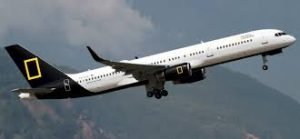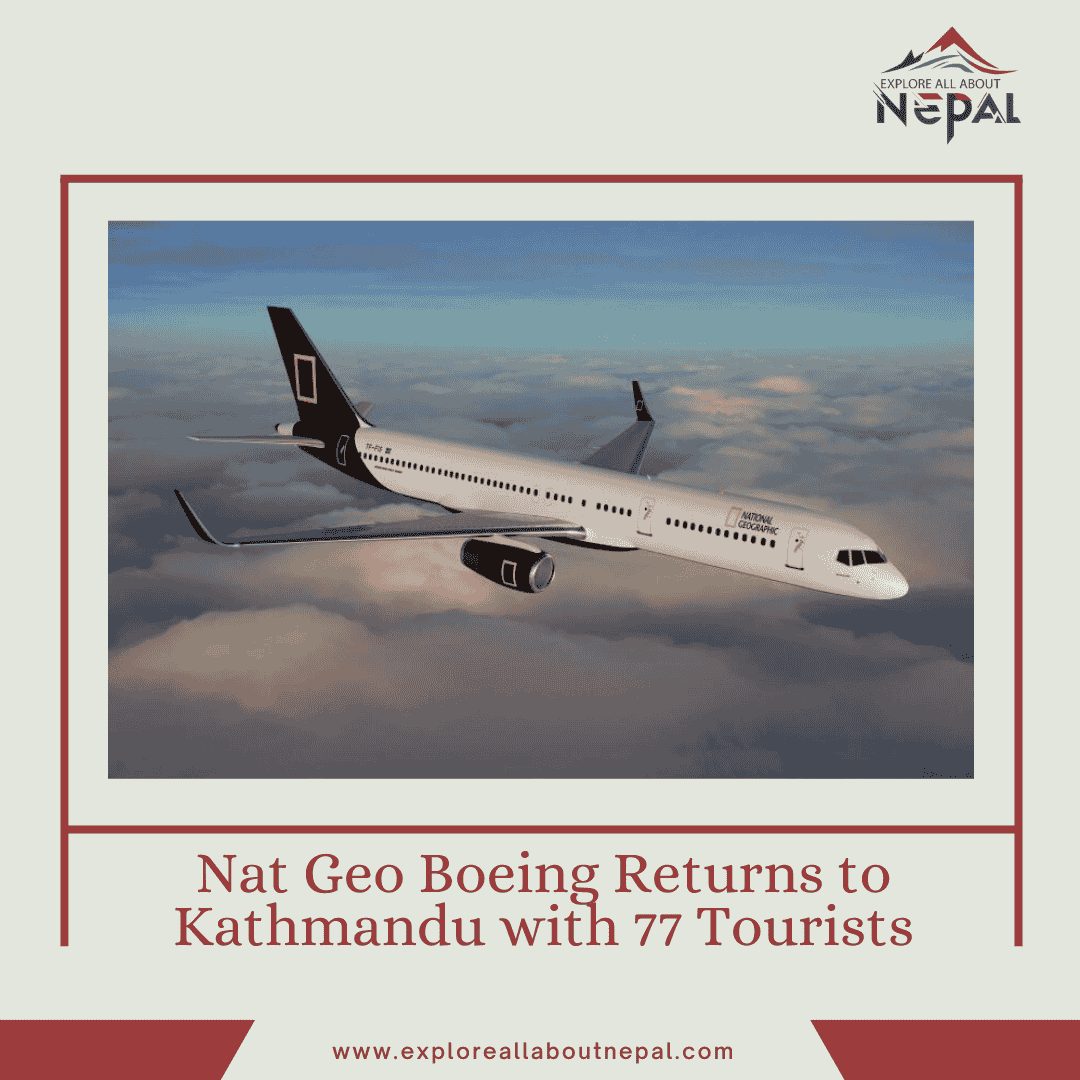Nat Geo Boeing Returns to Kathmandu refers to the recent arrival of a special Boeing aircraft operated for a National Geographic world tour, which landed at Tribhuvan International Airport (TIA) in Kathmandu, Nepal. The recent arrival of National Geographic’s Boeing aircraft in Kathmandu has garnered significant attention, not only for its distinguished passengers but also for the substantial fees incurred during its stay at Tribhuvan International Airport (TIA). This event underscores the intricate dynamics of international aviation operations, the economic implications for host airports, and the broader context of tourism in Nepal.

National Geographic’s Aerial Expedition
National Geographic, renowned for its explorations and documentaries, operates specialized aerial tours to provide unique experiences to its patrons. These tours often involve chartered flights to some of the world’s most exotic and remote locations, offering participants unparalleled insights into diverse cultures and landscapes.
In this instance, National Geographic’s Boeing aircraft embarked on a global journey, with Kathmandu being one of its highlighted destinations. The aircraft transported 77 American tourists eager to immerse themselves in Nepal’s rich cultural heritage and natural beauty. Such tours not only promote global understanding but also significantly contribute to the local economies of the destinations visited.
Financial Implications at Tribhuvan International Airport
Upon arrival at TIA, the National Geographic Boeing incurred daily fees amounting to 800,000 Nepalese Rupees (approximately USD 6,800). These fees encompass various charges, including parking, navigation, and other ancillary services essential for the aircraft’s operations and maintenance during its stay.
Breakdown of Charges
Tribhuvan International Airport has a structured fee system for international flights, as outlined in their official regulations:
Parking Charges: For international aircraft, the first three hours of parking are complimentary. Beyond this period, charges are applied based on the aircraft’s weight and duration of stay. For instance:
Aircraft up to 10,000 Kgs: USD 1.00 per 1,000 Kgs.
Aircraft between 10,001 Kgs and 100,000 Kgs: A base fee plus an incremental charge per additional 1,000 Kgs.
Aircraft above 100,000 Kgs: Higher base fees with incremental charges.
Navigational Charges: These are levied based on the aircraft’s weight:
Up to 25,000 Kgs: USD 45.90
25,001 Kgs to 50,000 Kgs: USD 76.50
50,001 Kgs to 75,000 Kgs: USD 152.75
Above 75,000 Kgs: USD 305.50
These charges are meticulously calculated to ensure that the airport recovers costs associated with hosting international flights, including maintenance, security, and administrative expenses.
Comparative Analysis: Parking Fees at TIA
To contextualize the fees incurred by the National Geographic Boeing, it’s insightful to compare them with charges for other vehicles at TIA:
Motorcycles and Scooters: As of recent revisions, these vehicles are charged NPR 40 per hour for parking.
Cars and Jeeps: The parking fee stands at NPR 80 per hour.
These rates have seen increments over the years, reflecting the airport’s efforts to manage space and resources effectively.
Economic Impact on Nepal’s Tourism Sector
The arrival of high-profile tours, such as that of National Geographic, has multifaceted benefits for Nepal:
Revenue Generation: Beyond the direct fees collected by the airport, the influx of tourists contributes to the local economy through expenditures on accommodation, food, transportation, and souvenirs.
Employment Opportunities: An increase in tourist arrivals often leads to job creation in sectors like hospitality, guiding services, and retail.
International Recognition: Hosting esteemed organizations enhances Nepal’s reputation as a premier travel destination, potentially attracting more tourists in the future.
Challenges and Considerations
While the benefits are evident, hosting large aircraft and groups also presents challenges:
Infrastructure Strain: TIA must ensure that its facilities can accommodate large aircraft without compromising service quality for other flights.
Environmental Concerns: An uptick in air traffic can have environmental implications, necessitating sustainable practices and policies.
Cultural Sensitivity: It’s imperative to balance tourism growth with the preservation of Nepal’s cultural and natural heritage.
Future Prospects
To capitalize on such opportunities, Nepal could consider:
Infrastructure Development: Investing in airport expansions and modernizations to handle increased traffic seamlessly.
Sustainable Tourism Initiatives: Implementing policies that promote eco-friendly tourism and minimize environmental footprints.
Enhanced Marketing Strategies: Collaborating with international organizations to showcase Nepal’s offerings to a broader audience.
Highlights
Nat Geo Boeing returns to Kathmandu, marking a major highlight in Nepal’s tourism calendar.
The much-anticipated Nat Geo Boeing returns to Kathmandu after completing its latest leg of a global expedition.
With 77 American tourists on board, the Nat Geo Boeing returns to Kathmandu for another cultural discovery journey.
As the Nat Geo Boeing returns to Kathmandu, local businesses gear up to welcome high-end travelers.
Once again, Nat Geo Boeing returns to Kathmandu, reinforcing Nepal’s image as a key destination in world tours.
After months of travel, the Nat Geo Boeing returns to Kathmandu, offering its passengers an immersive Himalayan experience.
Tribhuvan International Airport sees increased activity as Nat Geo Boeing returns to Kathmandu.
Nat Geo Boeing returns to Kathmandu, bringing international attention to Nepal’s aviation and hospitality sectors.
The tourism board celebrates as Nat Geo Boeing returns to Kathmandu with a group of elite explorers.
When Nat Geo Boeing returns to Kathmandu, it symbolizes a unique fusion of luxury travel and cultural exploration.
A special moment for aviation enthusiasts as Nat Geo Boeing returns to Kathmandu once again.
Nat Geo Boeing returns to Kathmandu, attracting media coverage and boosting Nepal’s tourism visibility.
Local hotels and tour operators benefit as the Nat Geo Boeing returns to Kathmandu.
As Nat Geo Boeing returns to Kathmandu, discussions arise on how to better accommodate future elite tours.
The iconic Nat Geo Boeing returns to Kathmandu, continuing its mission of exploring and documenting global wonders.
Conclusion
The recent visit by National Geographic’s Boeing to Kathmandu serves as a testament to Nepal’s allure as a global destination. While the associated fees highlight the economic aspects of such visits, the broader implications for tourism and international relations are profound. By addressing challenges and leveraging opportunities, Nepal can further solidify its position on the world tourism map.


